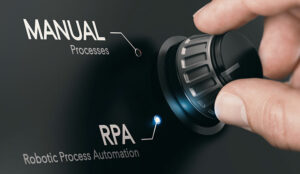Scott Merritt of Jacada introduces us to hyperautomation and how it goes beyond robotic process automation (RPA).
Hyperautomation is the latest and hottest trend in the tech world, driving demand for more advanced automation solutions that reach new corners of the enterprise.
This approach incorporates advanced technologies like artificial intelligence (AI), machine learning and robotic process automation to automate complex tasks that would otherwise require at least some human input. It’s no wonder that Gartner listed it as one of the top technology trends for 2020.
There is an enormous amount of untapped potential for hyperautomation to streamline, accelerate and enhance various workflows throughout organizations, including call centres.
However, it’s important to realize that applying hyperautomation is not a one-size-fits-all solution, especially when comparing automation tools designed for back-office processes against those created to support a better customer experience.
Here’s what you need to know about the next big thing in technology.
What Is Hyperautomation?
At its core, hyperautomation isn’t so much a new type of technology itself as it is a mindset and approach to automating processes.
The basic idea is to continue pushing automation, incorporating advanced technologies to improve it and applying it to increasingly sophisticated workflows, customer interactions, and jobs.
Ultimately, the biggest supporters of hyperautomation believe this approach will help organizations automate everything that can be automated.
In other words, your business will run as efficiently as possible since you have pushed automation as far as it can go – for the time being, that is.
Hyperautomation Case Study in Our Daily Lives
Consider the rapid evolution of automation supporting customer experiences within grocery stores:
- It wasn’t long ago when a typical grocery store checkout involved customers standing in long lines waiting on cashiers to type individual prices and quantities into their cash register for each grocery item.
- The first major iteration of automation into this highly manual process brought in the grocery conveyor belt and scanner which increased speed of checkout by over 50%.
- Self-checkout kiosks were next, adding a much-needed self-service component, giving customers the option to handle their own checkout and payment process. A self-service offering that still requires a human-in-the-loop aspect, as staff members have to be ready to troubleshoot problems, check IDs for alcoholic beverages and other issues that might come up.
- Amazon Go grocery stores take things a step further by removing cashiers and checkout registers altogether, allowing customers to grab what they need without waiting in line or scanning items.
- Now here we are in the middle of a pandemic where grocery delivery at your door is no longer a novelty enjoyed by a few but at times a necessity required by many. Enabled of course, by hyperautomation.
Hyperautomation Use Cases for Intelligent Customer Operations
When done right, hyperautomation can fully automate end-to-end processes while enhancing others that still require some manual oversight and control. It can also be used to engage your customers in any digital or live touchpoint.
Within the call centre, that means agents can spend less time on mundane and repetitive tasks and focus more on delivering excellent customer experience.
Outside of the call centre, it means companies can deliver fully automated interactions where customers are able to self-serve at their convenience and in their preferred experience.
In the back office, it means faster SLAs, quicker turnaround times on customer and employee enquiries, and other intracompany transaction processing across the organization.
Everyone stands to win with this approach as businesses can reduce their operational costs by increasing efficiency and eliminating manual errors. Employees will remove tedious work from their plates and devote their time to more meaningful and rewarding tasks.
Finally, customers will benefit from more self-service interactions and when needed, a more personalized hands-on experience.
How to Design for Hyperautomation
Many businesses are already investing in hyperautomation solutions, with Gartner predicting that 65% of organizations using RPA will pair those platforms with advanced tech like AI, machine learning and natural language processing, capabilities that make up the foundation of hyperautomation in any context.
Even so, not all hyperautomation platforms were designed for the same purpose or are equipped to handle the same processes.
Business leaders need to be careful about which solutions they adopt depending on the type of end-to-end process they are looking to automate, be it back office or customer-facing.
In any situation, let the business outcome dictate the approach and supporting platform rather than fall into the “one-size-fits-all” vendor trap.
How to Approach the Hyperautomation of Customer Interactions
Broadly speaking, hyperautomation supports two primary types of end-to-end processes:
- Supporting customer interactions in real time (via self-service and/or live interactions augmented by human agents) and
- Improving back-office operations which consists of both customer enquiry (next day processing) and intracompany transactions supporting departments like HR, IT, Finance, etc.
These are very different environments that require specialized capabilities from hyperautomation platforms to properly manage.
For self-service customer interactions, one human (customer) and one automation bot will always be engaged as they work together to assist the customer through an experience that may span multiple channels via one or many different automated solutions to include Intelligent Virtual Agents, Chatbots, Visual IVR, Web Self Service, etc.
While today’s digital self-service solutions can be relatively autonomous and carry out fairly simple tasks on their own, businesses have to assume many customers will eventually want to speak to a live agent either by choice or following an unsatisfactory resolution.
In fact, back in 2018, Forrester said that 60% of chatbots fail. Your own personal experience might confirm this is an ongoing issue to close the loop with customers.
As the customer interaction moves over to a live experience, a third party (call centre agent) now enters the process to add yet another layer of complexity.
The hyperautomation platform now has to manage the infamous “automation triangle” interaction between a customer, an agent, and an intelligent assistant bot.
Such human-in-the-loop processes are inherently more complex than back-office processes that often run without involving any person, at least not in real time like you see in CX hyperautomation use cases.
Back-office processes typically support call centre operations with “next day” processing where additional assistance is needed to resolve or follow up on tasks that could not be completed while the customer is on the line.
Some of the more simple yet manual processes that are business rule-driven make good candidates for RPA, but as process complexity increases, they can be further enhanced with a hyperautomation approach where intelligent document processing capabilities may be applied.
Automating these processes makes life easier for staff members and leads to shorter turnaround times for customers by shouldering time-consuming and tedious work so they don’t have to worry about it.
Although back-office automation affects the customer experience indirectly, it plays a supportive role rather than a customer-facing one.
Hyperautomation Is Not a One-Size-Fits-All Solution
There is no one single solution – RPA or otherwise – that can hyperautomate every call centre interaction and back-office workflow. The nature of the work is simply too varied for a one-size-fits-all approach.
By recognizing the differences in the type of work required to effectively manage call centre operations, business leaders can begin to zero in on the right solution for a particular job.
Author: Robyn Coppell
Published On: 28th Aug 2020 - Last modified: 30th Sep 2022
Read more about - Guest Blogs, Jacada





































